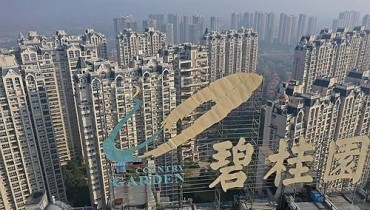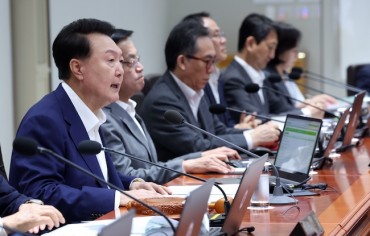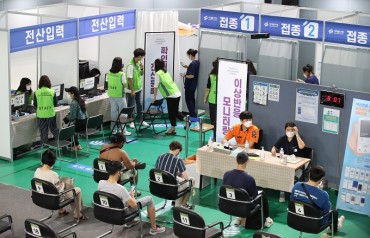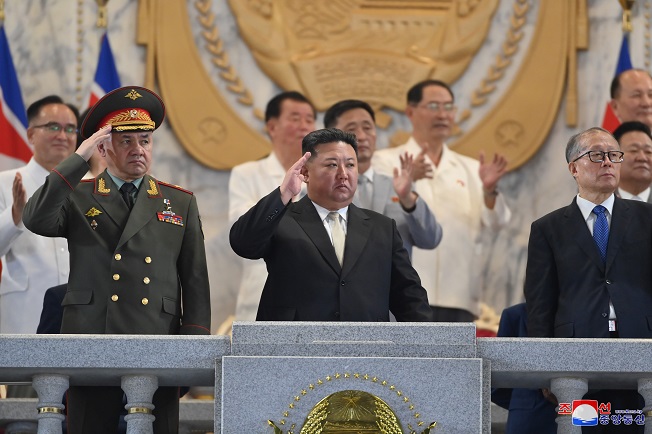
North Korean leader Kim Jong-un (C), Russian Defense Minister Sergei Shoigu (L) and Li Hongzhong, a politburo member of the Chinese Communist Party, attend a military parade in Pyongyang to mark the 70th anniversary of the armistice that halted fighting in the 1950-53 Korean War, in this photo released on July 28, 2023, by the North’s official Korean Central News Agency. (Yonhap)
SEOUL, July 28 (Korea Bizwire) — From its latest intercontinental ballistic missile (ICBM) to tactical weapons and a surveillance drone, North Korea’s vaunted military parade this week highlighted its defiant work under way to break through the closer-knit South Korea-U.S. alliance, analysts said Friday.
The North conducted the parade at Kim Il Sung Square in Pyongyang on Thursday night to mark the 70th anniversary of the Korean War armistice, celebrated in the country as Victory Day, in the presence of senior Chinese and Russian officials.
On the reviewing stand, leader Kim Jong-un was seen being flanked by Russian Defense Minister Sergei Shoigu and Li Hongzhong, a politburo member of the Chinese Communist Party — in a grandstanding display of the three countries’ solidarity at a time when Seoul, Washington and Tokyo are cementing their trilateral security ties.
As widely expected, the parade was a major showcase of the recalcitrant regime’s nuclear-capable tactical and strategic weapons that can target either South Korea or the U.S.
The North showcased columns of tactical missiles and long-range cruise missiles, followed by the display of Hwasong-17 and Hwasong-18 ICBMs — both capable of striking the continental United States.
The Hwasong-18 missile is a new-type solid-propellant that was test-fired twice earlier this year.
It has raised fears that Pyongyang could conduct a surprise ICBM launch as the solid-fuel platform takes less pre-launch preparation time than a liquid-fuel missile.
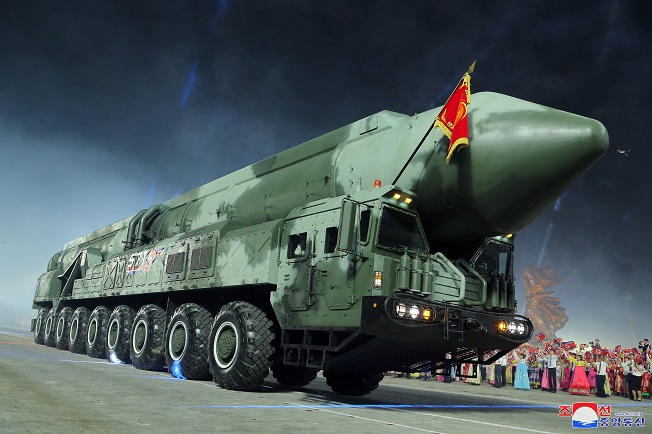
This photo, released by North Korea’s Korean Central News Agency on July 28, 2023, shows an intercontinental ballistic missile during a military parade under way at Kim Il Sung Square in Pyongyang to mark the 70th anniversary of the armistice that halted fighting in the 1950-53 Korean War. (Yonhap)
The KCNA cast the Hwasong-18 ICBM as the “most powerful core mainstay” of the North’s strategic force to “confidently protect our country” against hostile forces.
The Hwasong-17 ICBM is dubbed a monster for its sheer size. It is known to carry multiple warheads and have a range of around 13,000 km.
“Nuclear weapons for nuclear weapons, frontal confrontation for frontal confrontation,” the North’s official Korean Central News Agency said in an article describing the high-profile event.
The North’s ICBM programs have spawned concerns that the U.S. could dither on whether to come to the aid of South Korea should the ally come under attack due to the possibility that the ICBMs put its own cities at risk.
Mindful of the concerns, Washington has made a stronger deterrence commitment to Seoul.
“Through the display of such weapons, the North demonstrated the threat to both South Korea and the U.S.,” said Kim Yeol-su, a senior security expert at the Korea Institute for Military Affairs.
The appearance of a “strategic surveillance drone” at the event hinted that Pyongyang is striving to secure advanced intelligence, surveillance and reconnaissance (ISR) assets in the face of better-equipped South Korean and U.S. militaries.
The drone, first seen in the photos of a defense exhibition, looked akin to the U.S. unmanned high-altitude surveillance aircraft, Global Hawk, raising speculation that it is trying to make a copycat.
At the eighth congress of its ruling Workers’ Party in early 2021, the North announced it would push for the development of an unmanned aerial vehicle for surveillance with a range of 500 kilometers.
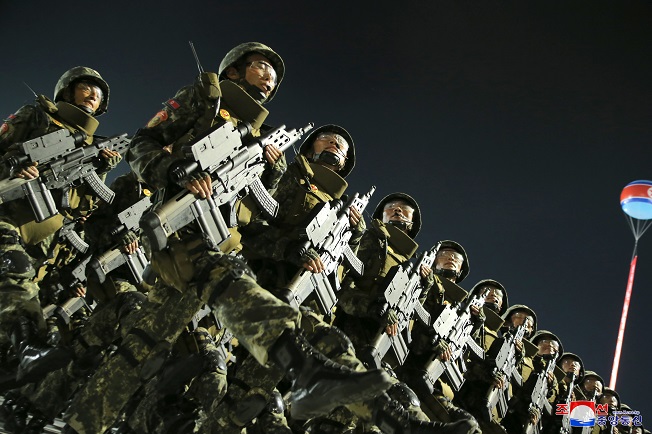
This photo, released by North Korea’s Korean Central News Agency on July 28, 2023, shows soldiers marching in formation in a military parade under way at Kim Il Sung Square in Pyongyang to mark the 70th anniversary of the armistice that halted fighting in the 1950-53 Korean War. (Yonhap)
Analysts said that if the drone is fully deployed, it would enhance the North’s military targeting capabilities.
“North Korea has difficulty detecting and tracking moving targets on the ground and at sea, though it may have coordinates for fixed ground-based targets, like airstrips or military command facilities in the South,” Nam Chang-hee, professor of international politics at Inha University, said.
“Given the military imperative to secure a multilayered, faceted ISR construct, it is a textbook step by the North to acquire such a drone,” he added.
North Korean leader Kim and Chinese and Russian officials watched the parade of goose-stepping troops and high-profile weapons together in another sign of their tight security partnerships amid growing security cooperation among South Korea, the U.S. and Japan.
Seoul, Washington and Tokyo have been firming up their trilateral partnership amid growing North Korean threats, China’s assertiveness and Russia’s war in Ukraine.
“With the presence of the Chinese and Russian officials at the parade, the North apparently seeks to assert its claimed legitimacy for the development of tactical and strategic nuclear arms,” Kim said.
(Yonhap)



